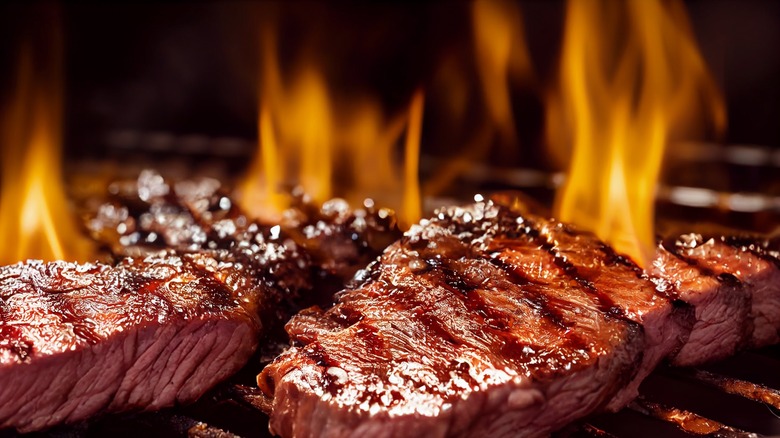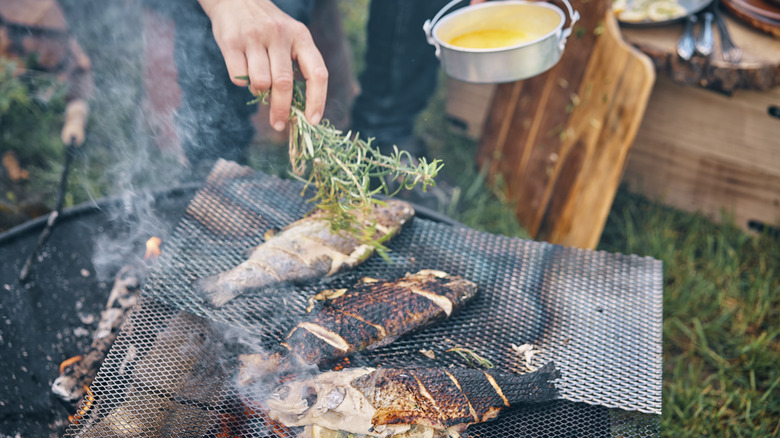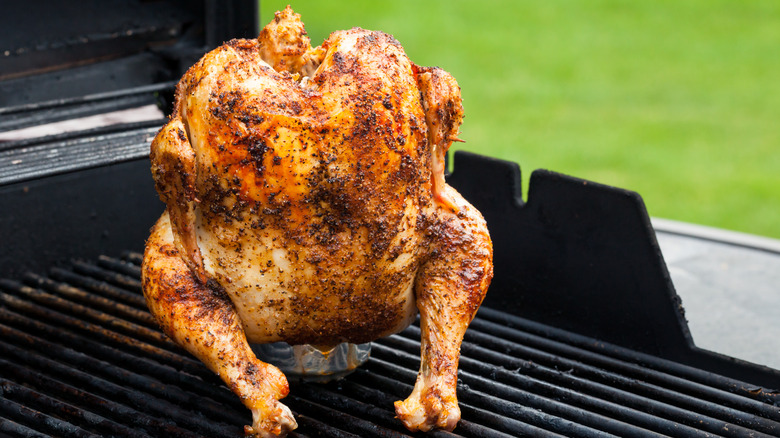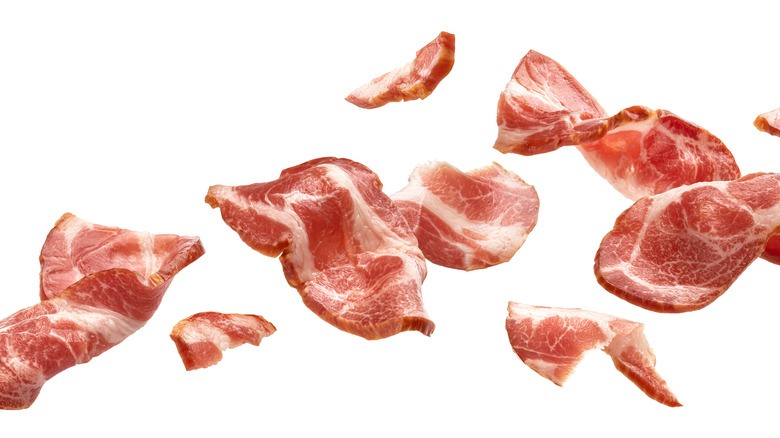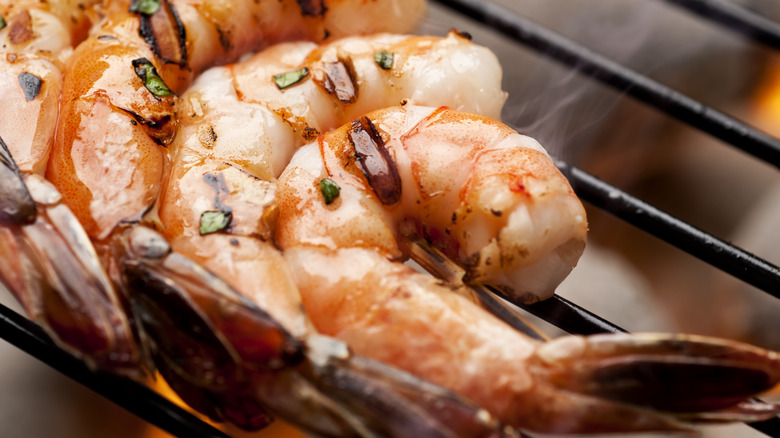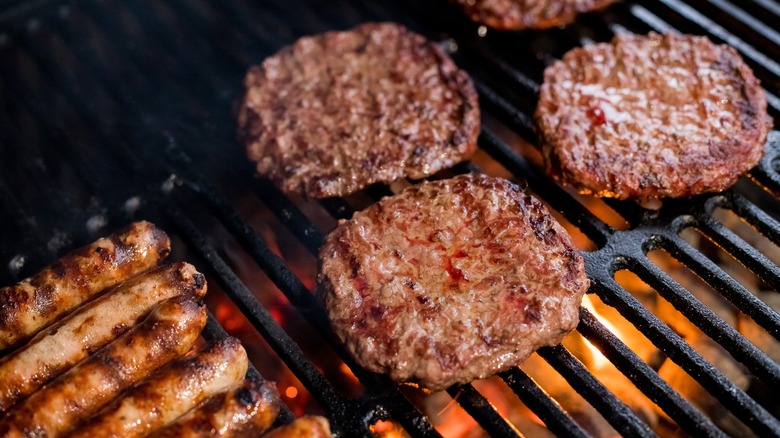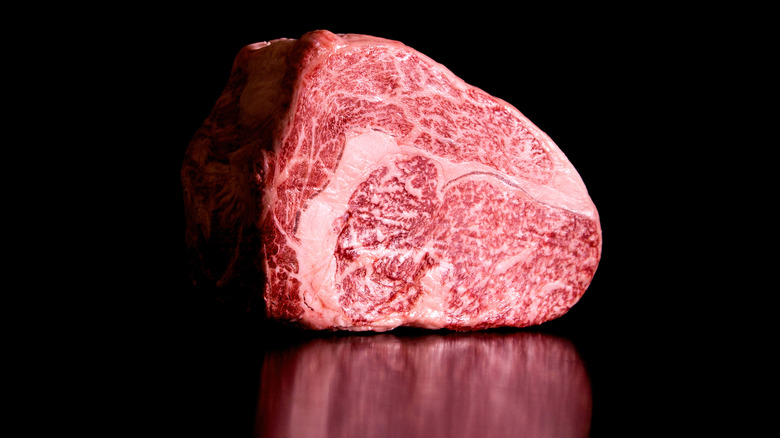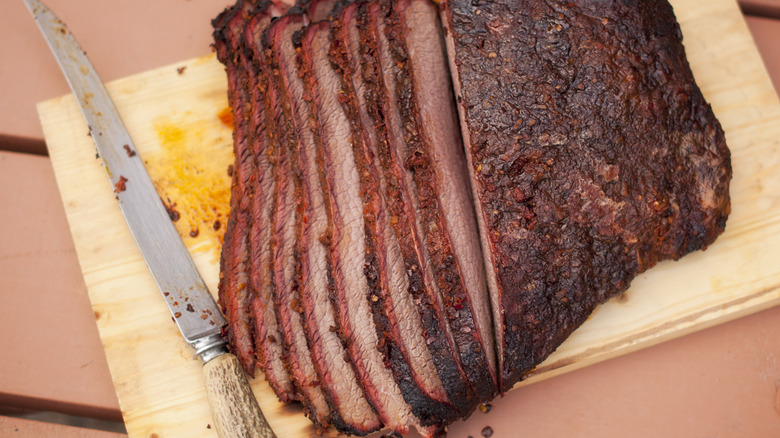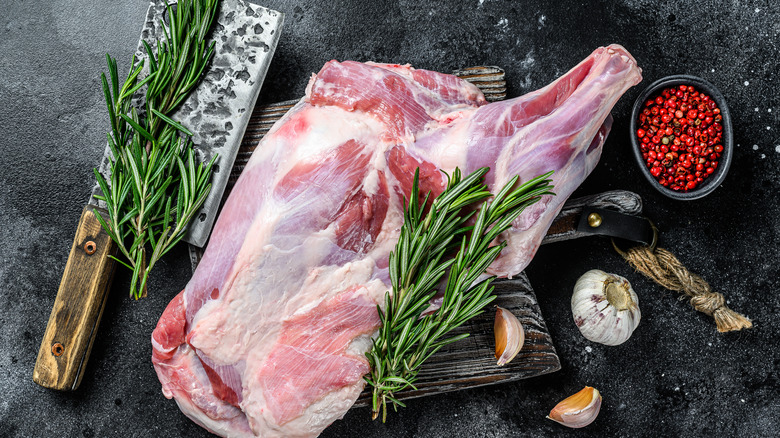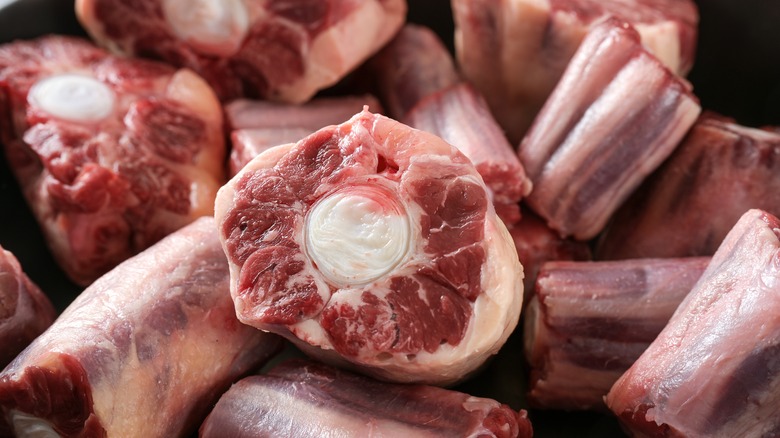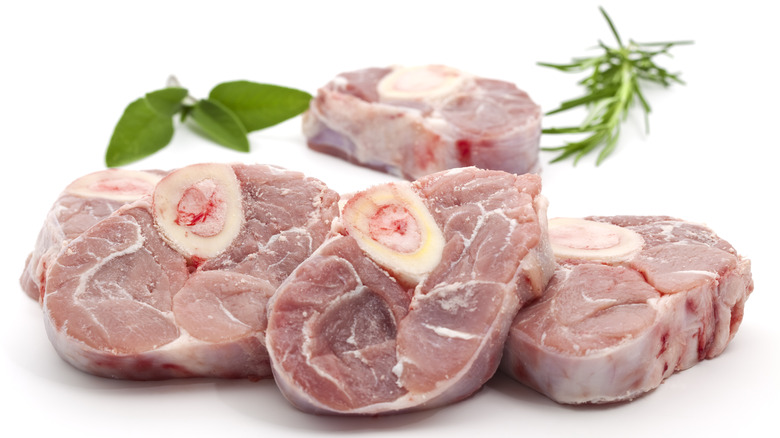10 Meats You Should Never Grill
Once you start grilling, it's hard to go back — but be forewarned: While a char-grilled steak is a delight, the grill is not equally kind to all cuts. From brisket to oxtail and bacon to scallops, some meats are best relegated to the kitchen rather than the backyard. "Not every piece of meat is destined for the grill," says Luis E. Mata, CEO of Meat N' Bone. "A discerning cook recognizes the necessity of matching each unique cut of meat with the cooking method that best accentuates its flavors and textures."
But Mata, like the other experts we interviewed, offers this info with a caveat. Although certain cuts of meat are more difficult to get right on the grill, in many cases, it's not a question of a total preclusion of grilling, but rather, of compounding skill with experience. "The success of grilling largely hinges on the cook's expertise," says Mata. "You can certainly grill almost anything, but the success of doing so greatly depends on the skill of the cook, or as we might affectionately call them, the Grillmaster. Quinto Miami executive chef Ivan Collazo agrees with this statement. "If you know how to properly manage the grill you can cook all different kinds of meat," he says. "So, I believe everything can be cooked on the grill."
That said, if you want to err on the side of caution, these are the meats that lend themselves badly — or in some cases, not at all — to grilling.
1. Delicate fish
A cedar plank salmon or skewer of shell-on shrimp are both marvelous cooked on the grill, but more tender fish like sole or tilapia are far from a barbecue's BFFs. "Many flaky white fish, including cod, tilapia, and branzino, are notably delicate on the grill," says Mata, noting that they are "notorious for their tendency to fall apart on the grill due to their delicate texture." And while this doesn't make them impossible to cook, they are indeed "more challenging to perfect."
That said, there are ways to circumvent their naturally delicate characteristics. Whole fish, for example, is easier to grill than a skinless fillet. Alternatively, using a cast iron pan or fish tray on the grill's grates can help you reap the best of both worlds, taking advantage of char-grilled flavor and eschewing the fuss. Indeed, with the right technique — and the right mastery of the grill — you can eventually get to a point where even delicate fish can shine on the grill.
"[At Quinto Miami] we have a snapper that has no grease, and we cook it directly on the grill," says Collazo. "So, it's not about what's too delicate, it's about the technique that you have on the grill." Mata agrees with this comment and adds, "Mastery of technique and careful handling are essential to successfully grilling these types of fish." If you're a grillmaster looking for a new challenge then give it a try, but if you're a live-fire neophyte, it's better to pass.
2. Whole poultry
Whole poultry can be hard to prepare in the best of circumstances, as the delicate breast meat often overcooks in the time it takes the dark meat to cook through. It's even more complicated on the grill, where you often have high heat coming exclusively from the bottom, risking less even cooking than in the oven. But according to our experts, it's not a question of entirely eschewing whole poultry on the grill but rather taking the time to prep it properly before forging forward.
"I would not be afraid of cooking a big piece of meat on the grill," says Mata, noting he has seen whole sides of beef cooked on a grill in countries in South America like Argentina or Brazil — a far larger cut than even the biggest of turkeys. He nevertheless acknowledges that such a mission could be tricky though doable with the appropriate method. "While larger or thicker cuts can be challenging, with the right techniques such as indirect grilling, rotisserie cooking, or reverse searing, and careful monitoring of internal temperatures, they can still be successfully grilled."
Meanwhile, chef Brad Wise of Rare Society, a steakhouse featuring an open-flame concept, adds that this is where having a good butcher comes in handy. "They can set you up for success here, spatchcocking or fabricating the meat in such a way to make it easier to cook all the way through," he says.
3. Bacon
It's tempting to assume that bacon's smoky flavor would only be magnified by a wood-fired grill, but the reality is that barbecuing your bacon is a bad idea, at least according to Amanda Frederickson, cookbook author and owner of Radish Kitchen. She tells Mashed that grilling bacon could prove a massive safety hazard given the high-fat content of this breakfast fave.
She explains that as bacon cooks, the fat is rendered, hitting the open flame and causing it to flare up. Not only can this combo of fat loss and potential scorching alter the flavor of your bacon, but it may even result in a dangerous grease fire. "Fat is extremely flammable when it hits an open flame and will cause flare ups of fire," she says. "The more grease or fat that hits the open flame, the bigger the flare up flame will become." According to Wise, the same holds true for pork belly, an unsmoked, thicker slab of bacon. "You want to cook this low and slow, because you want that fat to render and be fork tender," he says.
Either cut works well cooked in the oven, where the fat can slowly render. As an added bonus, a pan or tray will collect the flavorful liquid, which you can strain and save to cook with later. (Insider's tip: Bacon fat makes your morning eggs particularly exquisite!) If you're dead set on adding char-grilled flavor to bacon, consider using the grill to make toast for your BLTs.
4. Some seafood
Some fish and seafood are tailor-made for the grill, like lobster, which has a sweetness that is only magnified by the slight bitterness of the barbecue. But other pieces are more difficult to grill well. This is particularly true of delicate items like peeled shrimp, bay scallops, or abalone, which can be tricky to grill without overcooking. Given the size of certain seafood, it's especially easy for morsels to slip through the grates, resulting in expensive ash.
But Mata says that despite these dangers, grillmasters should not feel that the risks preclude such seafood from being cooked on the grill entirely. "Smaller just means more challenging," he says. "It will require more attention to cook something small like shrimp or scallops on a grill. But it's certainly doable."
When it comes to grilling shrimp — or any smaller piece of seafood, for that matter — your first course of action should be to thread the items on water-soaked wooden skewers. The skewer helps keep anything from slipping through the grates, and the extra moisture from the water prevents the skewers from charring in the flames. Marinate your seafood in a flavorful combo of olive oil, garlic, and herbs to lend even more moisture to it, and consider grilling shell-on shrimp for even more moisture and protection from the heat. Finally, whatever the seafood, be sure to cook it fast and hot for a charred exterior and an interior that remains juicy and flavorful.
5. Burgers
It might seem nuts, but according to restaurateur David Chang, grilling is far from the best way to make burgers shine. "I don't think I've ever had a transcendent backyard grilled burger experience," he says on his podcast, noting that despite the nostalgia of such a method, it actually results in quite a bit of moisture loss as the patty sizzles over the flames — and potentially even a dangerous flare-up.
But for Wise, burgers can be made just as juicy and delicious on the grill, as long as you've got your techniques down. "If your grill is hot enough, and you have the right fat content on the meat, you'll be fine," he says. "Also, don't press down on the burger when you grill it — that is going to cause all the juices to run off and the burger to become dry. And flip it less. Once per side."
Mata agrees, noting that the benefits of grilling burgers far outweigh the downsides. "Sure, grilling might lead to a bit more juice loss compared to other techniques," he says, "but it also brings its own set of perks to the table, such as those coveted grill marks and a unique texture." The only exception? If your burger is made with fatty wagyu. "A real burger made with A5 Japanese Beef is QUITE a challenge to cook on a grill," he says. "At The Wagyu Bar it is the only burger we cook on a cast iron skillet."
6. Japanese wagyu
Burgers aren't the only cut of wagyu probably best reserved for a pan. "Steaks that are excessively marbled or sliced too thinly tend to underperform on the grill," explains Mata, noting that this describes most — if not all — Japanese wagyu. Indeed, this decadently marbled cut is fairly wasted on a grill, where most of the fat will drip down onto the coals. Just like with bacon or burgers, this is as much an issue for the potential loss of flavor as it is for the risk of flammability — and singeing one's eyebrows is far from the ideal party game at a cookout. (It bears mentioning that some American wagyu is lower in fat than Japanese varieties and can therefore be cooked successfully on the grill. Ask your butcher if you're not sure.)
When it comes to luscious Japanese wagyu, Mata prefers a cast iron pan or skillet, which allows the fat to render out safely and deliciously. Indeed, according to Wise, the layer of rendered beef fat turns the pan into an even hotter cooking vessel than the already-ripping-hot grill. "Any wagyu cuts that have an extremely high-fat content, cooking it in a pan is going to give you a natural caramelized meat-sugar taste," he says, noting that this method brings out "the tenderness and rich flavors of the meat better than a grill."
7. Brisket
Brisket boasts loads of connective tissue, rendering it rich and succulent — if it's prepared correctly. Designed to be cooked low-and-slow, this cut does beautifully in a braise or in a smoker, when all of the collagen is able to soften and tenderize the flavorful meat. But brisket is a terrible contender for high-heat cooking, which only results in making it chewy. "Tougher cuts of meat that need more time to break down and become tender should not be grilled," says Wise. "Like a brisket. Roast, smoke, or braise that."
On the other hand, Mata notes that while this is true if you treat your grill as a high-heat cooking method, mastering the flame could allow you to perfect even these tougher cuts. "Cooking a brisket on the grill is entirely possible, but it demands patience and a thorough understanding of the 'low and slow' cooking method," he says. "This approach is crucial for rendering the connective tissues in brisket and other tougher cuts from the chuck of the animal, transforming them into tender and flavorful delights. The Grillmaster must be attuned to the intricacies of temperature control and cooking times to ensure that these challenging cuts reach their full potential."
If you're willing to put in the time and effort to master this technique, grilled brisket could indeed be a successful venture. But you may be better off reserving your brisket for the smoker and grilling a T-bone instead.
8. Leg of lamb
A leg of lamb is yet another cut that's most delicious when slow-roasted or braised, such as with a slow cooker leg of lamb recipe. Cooking it on the grill, according to Wise, won't be doing it any favors. This holds especially true given the fattiness of this particular cut of lamb.
A low-and-slow method allows the fat to render, making the meat itself even moister. Cooking such a cut over high heat will merely sear or even burn the fat, resulting in meat that's likely to be way too rare on the inside with a chewy layer of fat on the exterior — a less-than-appetizing means of preparing this expensive cut. A more traditional slow-roasted leg of lamb is a far more delicious option.
If you've got your heart set on grilling lamb, however, don't be discouraged. Lamb chops shine over the high heat of the grill — especially if you treat them right. Marinating them in olive oil and garlic will infuse them with flavor, and brushing extra marinade over top as they cook, along with a rosemary branch, will push them to next-level deliciousness.
9. Oxtail
Long overlooked as a cheap cucina povera cut, lumped in with offal like liver or chewy hanger steak, oxtail is finally getting its time in the spotlight, thanks to the rise in a nose-to-tail approach to eating meat. But while oxtail is certainly delicious, it's yet another cut that benefits far more from a low-and-slow approach than from high-heat grilling. According to Collazo, "any meat that has a low quantity of grease or that doesn't have too much muscle like beef tail or beef cheek" is best prepared this way to ensure they remain moist and tender.
But while this may be the case for the many cuts that hail from muscular parts of the animal, it holds especially true for oxtail, given the relatively paltry amount of meat on the tailbone. For each flavorful morsel to be easily removed and enjoyed, it needs to be tender enough to quite literally fall from the central bone. Hacking away at a grilled oxtail is way more work than it's worth, considering how tough and stringy the meat is if it's cooked over a quick, high heat like the grill. Instead, braise oxtail in a flavorful sauce made with soy sauce, wine, or tomatoes, or use a Jamaican recipe with ketchup and spices. After a few hours, the resulting meat will be so tender you'll basically be able to eat it with a spoon.
10. Osso buco
Leg of lamb, brisket, and oxtail are not the only meats better relegated to the slow cooker or an oven set to low heat than the grill. The same preclusion holds, according to Mata, for any fatty, collagen-rich cut, including but not limited to chuck roast, eye round, pork shoulder, beef shank, veal shank, osso buco, and "anything of the sort." "Something that you would traditionally cook for a long period of time because it would need to break down and tenderize should not be grilled," adds Wise. "Save it for the oven."
When it comes to osso buco specifically, a slow and moist method like braising is a better way to bring out its best characteristics. Osso buco is a cross-cut of veal shank sold on the marrow-filled bone, which is what gives the cut its name. (Osso buco translates to bone hole in Italian and refers to the hole that passes through the bone.) Given the way that marrow melts into sauces to render them rich, unctuous, and flavorful, it's no wonder that most traditional Italian recipes for this cut begin by searing the meat to add a touch of caramelization before finishing the cooking process in a low oven to render the meat tender and flavorful. A gremolata topping usually adds a touch of brightness to the finished braise. No matter how you try, you just won't be able to get the same result on the grill.
